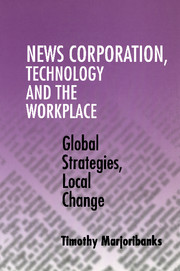Book contents
- Frontmatter
- Contents
- List of Tables and Figures
- Acknowledgements
- Abbreviation
- Introduction: Tales from the Workplace
- Part I Technological Innovation and Workplace Reorganisation: The Newspaper Industry
- Part II Technological Innovation and Workplace Reorganisation: News Corporation
- 4 News Corporation Limited: A Global Media Company
- 5 News International and Wapping
- 6 The Adelaide Advertiser: Wapping South?
- 7 News Corporation in the United States: The Land of Opportunity?
- 8 Conclusion: News Corporation: Combining the Global and the Local
- Bibliography
- Index
4 - News Corporation Limited: A Global Media Company
Published online by Cambridge University Press: 04 August 2010
- Frontmatter
- Contents
- List of Tables and Figures
- Acknowledgements
- Abbreviation
- Introduction: Tales from the Workplace
- Part I Technological Innovation and Workplace Reorganisation: The Newspaper Industry
- Part II Technological Innovation and Workplace Reorganisation: News Corporation
- 4 News Corporation Limited: A Global Media Company
- 5 News International and Wapping
- 6 The Adelaide Advertiser: Wapping South?
- 7 News Corporation in the United States: The Land of Opportunity?
- 8 Conclusion: News Corporation: Combining the Global and the Local
- Bibliography
- Index
Summary
News Corporation Limited has been referred to variously as ‘the most global of all communications companies’ (Koschnick 1989:98), and as ‘the largest media group in the western world’ (Advertiser Newspapers Limited 1986:20). Its Chief Executive, Rupert Murdoch, has been described as ‘the most conspicuous of the high rollers in die media acquisition business [in die 1980s and 1990s]’ (Emery, Emery widi Roberts 1996:594), and as ‘the man who would buy die world’ (Mail and Guardian (South Africa) 1995:22). Analyses of its media holdings certainly support die notion that News Corporation is a truly global media company. In 1998, News Corporation, which has its registered office in Adelaide, South Australia, and its head office in Sydney, New South Wales, owned newspapers in Australia, New Zealand, Fiji, Papua New Guinea, die United Kingdom and die United States of America. Earlier in die 1990s, News Corporation had owned papers in countries as diverse as China and Hungary. The company also had global holdings in magazines and inserts, book publishing, television, filmed entertainment, satellite television, commercial printing, and various their operations including transport, computer and electronic technology, and music. In die financial year ending 30 June 1998, revenues of News Corporation totalled US$12.8 billion, an increase of 14 per cent on die previous year, while operating earnings grew to US$1.22 billion, an increase of 21 per cent (Murdoch 1998). Table 4.1 provides details of die revenues earned by News Corporation in its three major areas of operation, die United States, die United Kingdom, and Australasia.
- Type
- Chapter
- Information
- News Corporation, Technology and the WorkplaceGlobal Strategies, Local Change, pp. 93 - 100Publisher: Cambridge University PressPrint publication year: 2000



